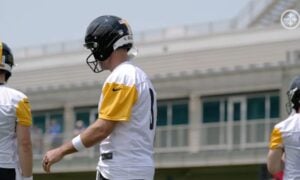For Pittsburgh Steelers fans, the late 1960s were a grind, yet they marked a pivotal shift. In 1966, Art Rooney Sr. hired Bill Austin at age 37 as head coach, his final major decision before Dan Rooney took over. Although Austin’s three-year tenure ended with an 11-28-3 record, it laid groundwork for the dynasty to come. Endorsed by Vince Lombardi, Austin brought intelligence and discipline. However, he struggled to inspire victories. For the average fan, Austin’s story bridges our lean years to Chuck Noll’s glory, illustrating how setbacks forged the Steelers’ identity.
Early Life and College Career
Born on Oct. 18, 1928, in San Pedro, California, Bill Austin grew up near Portland, Oregon and graduated from Woodburn High School. A prodigy, he began school at 4 years old, played varsity football at 16, and joined Oregon State during World War II when freshmen could play. As a tackle, he earned All-Coast honors in 1948 and starred in the 1949 East-West Shrine Game, entering the NFL by 20 with relentless drive.
NFL Playing Career and Early Coaching
In 1949, the New York Giants drafted Austin in the 13th round (126th overall). Over seven seasons as an offensive guard, he started 60 of 76 games, contributed to the 1956 NFL Championship, and earned a 1954 Pro Bowl nod. The NY Daily News praised his “fine straightaway charge” and pass-blocking prowess. Military service from 1951 to 1952 in San Francisco and Tokyo paused his playing career, but he coached the Far East Asia Champions in Japan’s Camp Drake League, igniting his coaching passion. Despite injuries — a separated shoulder, dislocated elbow, broken nose, and gashed head — he rarely missed games. After retiring in 1957 following knee surgery and a contract dispute, he coached at Wagner College while still a Giant and then at Wichita State in 1958, mentoring tackle George Hershberger, later a Steelers draft pick.
Vince Lombardi’s Mentorship
In 1959, Vince Lombardi, Austin’s former Giants offensive coordinator, hired him as Green Bay’s line coach at age 29, one of the NFL’s youngest assistants. Lombardi’s guidance was transformative. Austin scouted opponents, recruited college talent and coached scrimmages, shaping an elite offensive line featuring Hall of Famers Forrest Gregg and Jim Ringo, alongside Jerry Kramer and Fuzzy Thurston. For example, his adjustment of moving tackle Bob Skoronski to center in 1964 kept the line strong despite injuries. Consequently, Austin helped Green Bay reach three straight NFL Championships (1960-1962), winning in ’61 and ’62 and earning Lombardi’s glowing praise.
Path to Pittsburgh
In 1965, seeking a warmer climate for his wife’s health, Austin joined the Los Angeles Rams as an assistant. He reduced sacks from 65 to 45 and installed Ken Iman as a decade-long starting center. His knowledge of Green Bay’s offense helped the Rams split two games against the 1965 champion Packers. When the Steelers, stuck in three straight losing seasons, sought a coach, Lombardi called Austin “perhaps the best young coach in the league.” In January 1966, Art Rooney Sr., with Dan Rooney’s input, hired the 37-year-old. Art acted swiftly, spurred by Austin’s interview with the St. Louis Cardinals and Lombardi’s praise, while Dan preferred a broader search but deferred, marking Art’s last major coaching decision.
Steelers Tenure: A Transitional Era
Austin’s three seasons (1966-1968) with the Steelers blended hope and frustration. Tasked with reviving a team coming off a 2-12 record under Mike Nixon in 1965, he faced daunting challenges.
1966 Season: Training camp in Rhode Island exposed weaknesses, particularly in the offensive line. They gave up 66 sacks during the season. This contributed to quarterback Bill Nelsen’s injuries, limiting him to five games, which stalled momentum. Moreover, losing defensive captain John Baker to injury hurt, but Austin lifted the team to 5-8-1, highlighted by a 57-point rout of the expansion Atlanta Falcons.
1967 Season: Camp shifted to Saint Vincent College, now a lasting tradition. Austin intensified conditioning, but the team slipped to 4-9-1. Releasing popular Pro Bowl veteran Brady Keys midseason caused tension on the team; Keys called Austin “difficult” yet valued his Pittsburgh ties. Close losses to Dallas and the Giants stung, and a traded first-round pick from Buddy Parker’s era limited young talent.
1968 Season: A dismal 2-11-1 record, with six- and five-game losing streaks, hit rock bottom and sealed Austin’s fate. The offense scored only 244 points, while the defense allowed an NFL-high 397. Despite this, four players — Roy Jefferson, Andy Russell, Dick Hoak and Ben McGee — earned Pro Bowl honors. Rookie Rocky Bleier played 10 games before his Vietnam draft. However, off-field drinking, as noted by center Ray Mansfield, overshadowed discipline. Dan Rooney wrote in his autobiography that Austin “had lost the team,” prompting a coach search before the season ended.
Austin’s 11-28-3 record (.298 winning percentage) fell short, but his era saw a leadership shift. Art Rooney Sr.’s direct influence waned as Dan Rooney stepped up, setting the stage for a new era.
Austin vs. Noll: The Missing Element
Austin’s hire foreshadowed Chuck Noll, hired in 1969 at age 37 by Dan Rooney after Joe Paterno declined. Both were young, intelligent, first-time head coaches backed by legends — Lombardi for Austin, Don Shula and Paul Brown for Noll. Both faced a rebuilding challenge. Yet, Noll’s ability to inspire players was the missing element in Austin’s tenure. For instance, Brady Keys’ critique and the 1968 collapse highlighted Austin’s struggles with motivation, while Noll’s leadership built a dynasty with four Super Bowl titles. Moreover, Noll’s draft pick, Joe Greene in 1969, embodied a hate-to-lose mentality that became the cornerstone of Pittsburgh’s success. Austin’s tenure clarified the need for a coach to grow with the team and ignite a will to win.
Legacy: A Model for Pittsburgh’s Future
Bill Austin’s Pittsburgh tenure, the last under Art Rooney Sr.’s primary lead, set a hiring blueprint despite its struggles. His profile — young, intelligent, Lombardi-endorsed — mirrored future hires like Noll (1969), Bill Cowher (1992) and Mike Tomlin (2007), all first-time head coaches in their 30s with strong endorsements. This model, emphasizing potential and competitiveness, drove Pittsburgh’s success, from Noll’s four Super Bowls to Cowher’s and Tomlin’s titles. Furthermore, the Steelers’ practice of honoring Austin’s three-year contract, yet not renewing it due to lack of progress, reflects their enduring approach to coaching stability. Though lesser known today, he remains a pivotal figure whose challenges shaped today’s Steelers leadership model.
Post-Steelers Career
In 1969, Austin rejoined Lombardi as Washington’s line coach. When Lombardi died of cancer on Sept. 3, 1970, Austin became head coach, finishing 6-8 before being fired. Subsequently, he coached offensive lines for the Bears (1971), Cardinals (1972), Redskins (1973-1977), Giants (1979-1982) and Jets (1985), and served as the USFL’s New Jersey Generals offensive line coach (1983-1984).
His 17-year post-Steelers career highlighted his expertise as a superb positional coach. After his brief head coaching stint, he excelled as an assistant, leaving a lasting impact on offensive line coaching across multiple teams.
Inducted into Oregon State’s Athletics Hall of Fame and the Oregon Sports Hall of Fame, Austin died in Las Vegas on May 22, 2013.
Your Song Selection
To capture Austin’s bittersweet tenure, I choose “My City of Ruins” by Bruce Springsteen. Its soulful take on struggle and renewal mirrors the fan experience in Austin’s years — tough times with hope for a brighter future, fitting Pittsburgh’s resilient spirit.








